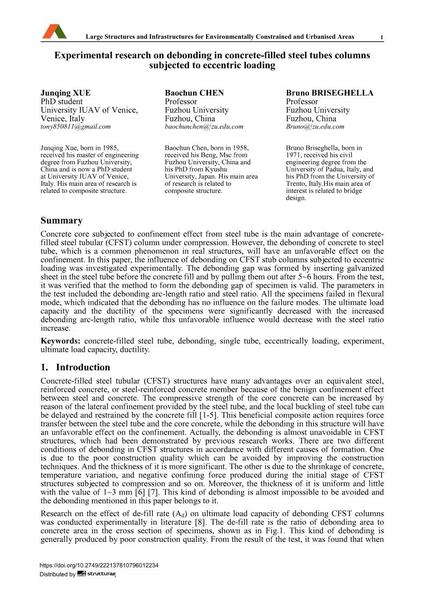Experimental research on debonding in concrete-filled steel tubes columns subjected to eccentric loading

|
|
|||||||||||
Détails bibliographiques
| Auteur(s): |
Junqing Xue
Baochun Chen Bruno Briseghella |
||||
|---|---|---|---|---|---|
| Médium: | papier de conférence | ||||
| Langue(s): | anglais | ||||
| Conférence: | IABSE Symposium: Large Structures and Infrastructures for Environmentally Constrained and Urbanised Areas, Venice, Italy, 22-24 September 2010 | ||||
| Publié dans: | IABSE Symposium Venice 2010 | ||||
|
|||||
| Page(s): | 132-133 | ||||
| Nombre total de pages (du PDF): | 8 | ||||
| Année: | 2010 | ||||
| DOI: | 10.2749/222137810796012234 | ||||
| Abstrait: |
Concrete core subjected to confinement effect from steel tube is the main advantage of concrete- filled steel tubular (CFST) column under compression. However, the debonding of concrete to steel tube, which is a common phenomenon in real structures, will have an unfavorable effect on the confinement. In this paper, the influence of debonding on CFST stub columns subjected to eccentric loading was investigated experimentally. The debonding gap was formed by inserting galvanized sheet in the steel tube before the concrete fill and by pulling them out after 5~6 hours. From the test, it was verified that the method to form the debonding gap of specimen is valid. The parameters in the test included the debonding arc-length ratio and steel ratio. All the specimens failed in flexural mode, which indicated that the debonding has no influence on the failure modes. The ultimate load capacity and the ductility of the specimens were significantly decreased with the increased debonding arc-length ratio, while this unfavorable influence would decrease with the steel ratio increase. |
||||
